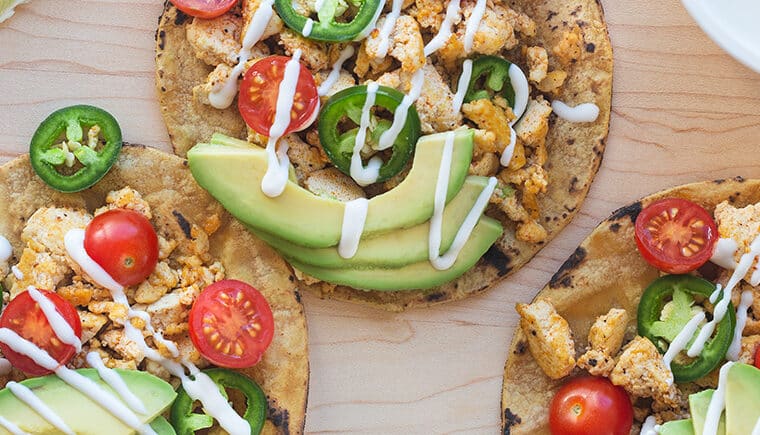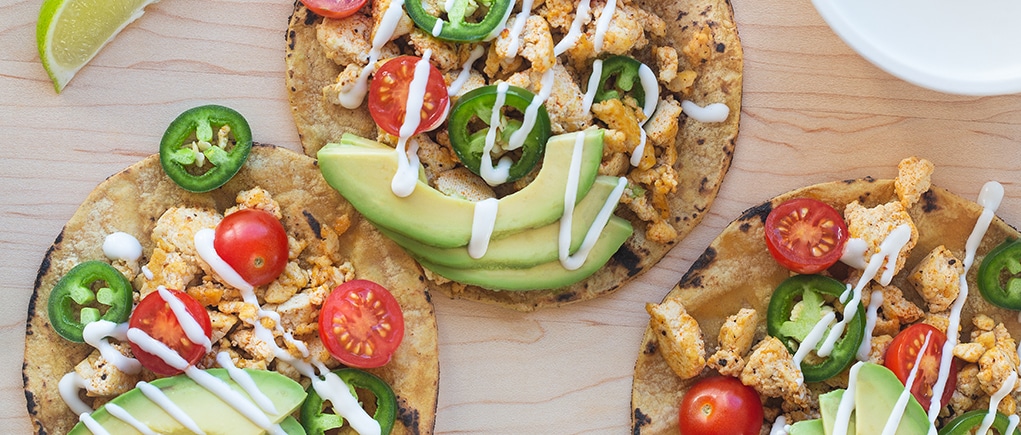



Going vegan can have tremendous benefits, but this big lifestyle change is not something you should do overnight. A dietitian breaks down the steps for going vegan and answers the most asked vegan questions.
If you’re interested in how to be vegan, you are not alone. Almost 10 million Americans claim to follow a vegan diet, and for good reasons: A vegan diet provides several health benefits, it’s more environmentally friendly, and supports animal welfare. However, the thought of completely switching your diet can seem overwhelming, and even daunting. Knowing where to get your nutrients, what foods to eat, and how to eat out are valid concerns people have when making the switch. Most importantly, you may be wondering, what does being vegan mean? Not to worry – we’ve got you covered with a dietitian-approved guide on becoming vegan.
A vegan diet excludes all animal products including meat, poultry, fish, seafood, eggs, dairy, and honey. This way of eating includes all foods made from plants such as fruits, vegetables, whole grains, legumes, nuts, and seeds. People may choose to follow a vegan diet for health reasons, environmental reasons, animal welfare, or all the above. However, simply being ‘vegan’ does not necessarily mean you are following a healthy diet. Nowadays, grocery stores are bursting with highly processed vegan foods that contain high amounts of artificial ingredients, refined sugars, sodium, and saturated fats. A healthy vegan diet comprises mostly wholesome, minimally processed ‘real’ foods such as fruits, vegetables, whole grains, legumes, nuts, and seeds.
While a vegan diet excludes all animal-based foods, a vegetarian diet only excludes animal ‘flesh’ but still allows for animal byproducts such as eggs, dairy, and honey. More recently, a new term, ‘plant-based diet,’ has become increasingly popular. Although there is no official definition, a plant-based diet focuses on foods that come primarily from plant sources. While some people use ‘vegan’ and ‘plant-based’ interchangeably, others refer to ‘plant-based’ as a diet that still includes animal products, but in significantly smaller proportions.
Several factors influence one’s decision to adopt a vegan diet. Some of the most popular reasons include:
The health benefits of a vegan diet are the top reason why people decide to make this lifestyle change. A whole-food vegan diet has been shown to improve health markers such as cholesterol, blood pressure, body weight, body mass index (BMI), blood sugar levels, and inflammation. This in turn, reduces the mortality and the risk of developing chronic diseases – and leading causes of death – including heart disease, type 2 diabetes, and some types of cancer. A plant-based diet has also been associated with a lower risk for cognitive disorders such as Alzheimer’s disease and dementia.
Researchers argue that going vegan is the single biggest way to reduce our impact on the planet. This is because plant-based foods are much more sustainable to produce than animal products. Research indicates that greenhouse gas emissions from animal-based foods are double those of plant-based foods. Meat production, especially red meat, requires an enormous amount of natural resources such as land, water, crops, and energy. Livestock production, which includes meat, milk, and eggs, uses one-third of the world’s water supply.
Many who choose a vegan diet do so for moral and ethical reasons. Given that a vegan diet excludes animal products, it does not contribute to animal pain and suffering. Animals that are raised for food are often mistreated during their lives and then slaughtered for human consumption. By not consuming meat and animal products, vegans are reducing the demand for animal agriculture and, therefore, animal cruelty.
Contrary to popular belief, vegans who are consuming a well-rounded and balanced diet get more than enough protein in their diets. Protein deficiency is extremely rare in developed countries. The best sources of vegan protein include legumes such as soy (tofu, tempeh, edamame, and soy milk), beans, chickpeas, lentils, green peas, and peanuts, as well as nuts and seeds. Even foods that are higher in carbohydrates can contribute to one’s protein intake – these include whole grains such as oats, brown rice, quinoa, and buckwheat, as well as vegetables such as leafy greens, broccoli, brussels sprouts, artichokes, mushrooms, and asparagus.
A balanced vegan diet includes a variety of nutrient-dense foods that provide an abundance of vitamins and minerals. However, there are a few nutrients that vegans need to pay special attention to. Vitamin B12, for example, is an essential vitamin for human health that is produced by bacteria in the soil. While animals can absorb this vitamin, plants cannot. Although some plant-based foods are fortified with vitamin B12, supplementation is a more effective way to meet your vitamin B12 needs as supplements have a higher bioavailability. Except for vitamin B12, a well-balanced vegan diet, one that includes fortified foods, should provide adequate amounts of all vitamins and minerals. However, you can still fall short of essential nutrients if your diet is not well-planned. In this case, your physician may recommend supplements to treat a nutrient deficiency, and you should consult with a dietitian to ensure your diet meets all nutritional requirements.
If you asked this question 10 years ago, it would be much more difficult to answer it. Nowadays, substituting dairy is extremely easy, so if you’re going vegan now, you are in luck. Dairy alternatives are becoming more and more accessible. Whether you’re looking for vegan cheese, milk, sour cream, yogurt, or ice cream, you are very likely to find several options in your local supermarket. Here are some easy dairy swaps:
When eating out, always ask the waiter about vegan options. You will be surprised to learn that most restaurants are now familiar with vegan diets and can accommodate those with dietary restrictions. Otherwise, you can always ask them to modify meals. Most often, removing any cheese, butter, cream-based sauces and dressings, or meat from meals will automatically make them vegan. For example, if you are ordering pasta, you can request that your pasta be cooked with olive oil instead of butter, with marinara sauce, and roasted vegetables, with no cheese on top. When ordering tacos, you can swap the meat for beans, and the sour cream for guacamole. If eating sushi, ask for a veggie-only option, soups, and salads. Another trick is to look at the menu and locate any legumes, vegetables, and whole grains that are offered, even if they come as part of a non-vegan meal. If the item is available at the restaurant, it likely means they can offer it to you as part of a vegan meal.
Pro tip #1: Always check the menu ahead of time before going to a new restaurant.
Pro tip #2: Always check the ‘Sides’ menu. You will likely find vegan options there. Foods such as rice, beans, roasted vegetables, and salads are often available as ‘sides,’ so if the main menu doesn’t offer any vegan meals, you can order several ‘sides’ and build your meal.
Vegan eating can be extremely filling and delicious. One easy way to ensure you are getting adequate calories and nutrients is to plan your meals to always include a source of plant-based protein, fruits and/or vegetables, whole grains, and a source of healthy fats. For example, a day of vegan eating could look like this: Cashewmilk yogurt with fresh berries and granola for breakfast, a quinoa bowl with beans and sauteed greens for lunch, a bowl of fresh fruit and mixed nuts for a snack, and tofu stir-fry with brown rice and roasted vegetables for dinner.
If you’re wondering whether a vegan diet is a right choice for you, here are some questions to consider:
If you answered yes to any of these questions, then a vegan diet can be appropriate for you! Take note of the next steps to ensure a successful transition.
The number one reason why people fail to transition to a vegan diet is that they try to do it overnight, cold turkey. Unless you know exactly what you’re doing, it’s unlikely that switching your diet overnight will work. Without enough preparation, you will end up not knowing what to eat, feeling hungry, craving animal foods, and not getting enough nutrients. Instead, take baby steps and do it in phases, focusing on making one change at a time. First, you can familiarize yourself with the best plant-based sources of protein and other important nutrients, and start incorporating them into your diet, without removing anything. Then, you can start swapping a few items such as dairy products with dairy-free alternatives. Forager Project offers a variety of cashewmilk yogurts that make the transition to non-dairy easier. You can also adopt ‘Meatless Mondays’ by consuming a vegan meal once a week and then working your way up to do it more frequently. Finding a method that works for you and going at your own pace is extremely important when making any lifestyle changes.
Eating a vegan diet that doesn’t meet your nutritional requirements may benefit the animals and the Earth, but will not benefit your health. The best way to learn where and how to get all your nutrients is by consulting with a registered dietitian before transitioning to a vegan diet. A dietitian can help you plan your vegan diet to ensure it is balanced and meets all your nutritional needs. It is particularly important that you learn the best sources of micronutrients and ways to improve nutrient absorption on a vegan diet. Iron, zinc, omega-3 fatty acids, calcium, vitamin D, and iodine are some of the nutrients that require special attention when going vegan, as they may not be as readily available in plant sources.
A big mistake when going vegan is to remove all animal products from the diet at once, without knowing how to replace them adequately to meet nutritional needs. A more effective strategy is to start by adding plant-based foods before subtracting animal-based foods. For example, begin to incorporate more legumes such as beans, lentils, chickpeas, and tofu, before removing animal proteins such as meat, poultry, eggs, and fish. This will allow you to become familiar with vegan protein sources, learn how to cook them and experiment with different recipes to find which you like best. The same goes for all other categories of foods – whole grains, nuts, seeds, fruits, and vegetables. Only after you have incorporated them more regularly into your diet can you start eliminating animal foods, slowly.
Going vegan is a big lifestyle change. It’s a process that takes time, and some may experience a big learning curve. And that is OK! Know that you will have challenges to overcome, and be kind to yourself. The simple fact that you are willing to go vegan – whether for your health, the planet, or animals – is already very noble. If you do eat non-vegan foods, whether accidentally or intentionally, take a step back and remember why you went vegan in the first place or identify how you can avoid it next time. Having a defined purpose for going vegan is a crucial step in your transition that will keep you motivated and inspired. Don’t go vegan only because people are doing it, or because it’s a ‘trend.’ Go vegan because you want to do better for your health, the health of the planet, or the well-being of animals.
The internet is a never-ending vegan recipe book. It is filled with tasty vegan recipes, many designed to mimic, or even improve upon, the flavor of non-vegan recipes. A fun activity is to veganize your favorite recipe so that you are not missing anything. Take baking, for example, you can easily substitute eggs, milk, and butter in virtually any baked recipe. Additionally, finding a vegan buddy or support group can be extremely helpful when trying to navigate ‘vegan waters’ by learning from those who have gone through the transition successfully.
Whether it’s for a recipe, a meal, or forever, going vegan doesn’t have to be difficult. By following these simple steps, you can comfortably transition into a plant-based diet without feeling lost… or hungry.
About the author:
Carolina Schneider, MS, RD is a registered dietitian specializing in plant-based nutrition and wellness. She is passionate about evidence-based nutrition and educating individuals on how to eat better – but not less – for optimal health.

Forager Project is a family-owned and operated organic food company, crafting plant-based foods in California since 2013.